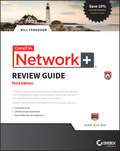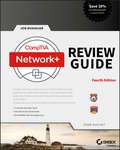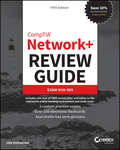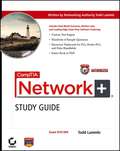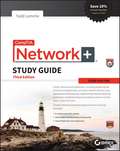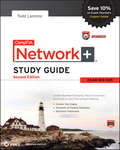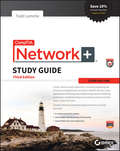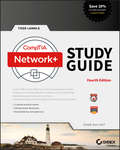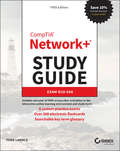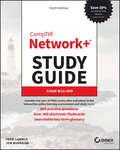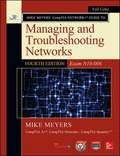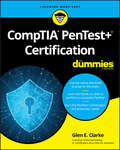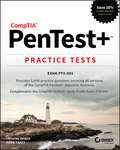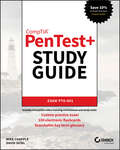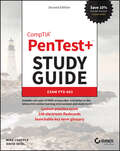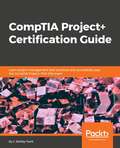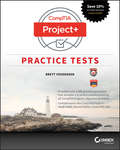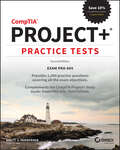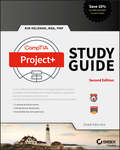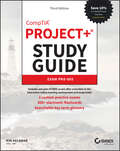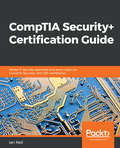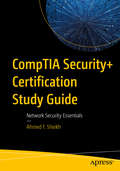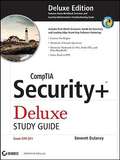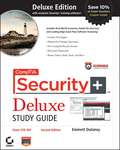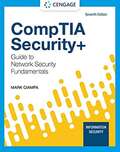- Table View
- List View
CompTIA Network+ Review Guide
by Bill FergusonFast, focused review for the latest CompTIA Network+ Exam N10-005CompTIA's Network+ certification is the leading non-vendor networking certification in the world and has become the standard certification for networking professionals. Make sure you're ready for CompTIA's new Network+ certification (exam N10-005) with this new edition of Sybex's CompTIA Network+ Review Guide. This concise guide is efficiently organized by exam objectives and covers all five exam domains. The book also includes 50 chapter review questions, as well as access to two online practice exams, and much more. It's the perfect companion to Sybex's CompTIA Network+ Study Guide, Second Edition or any Network+ study tool.Helps students prepare for the leading non-vendor-specific networking certification, CompTIA Network+This new edition is fully updated for Exam N10-005, the latest revision of the CompTIA Network+ exam Conveniently organized by exam objectives for quick reviewFeatures Exam Essentials in each chapter to help you focus on what you need to know for the examProvides access to practice exams, and other practice toolsReview all Network+ Exam N10-005 exam objectives and reinforce your studies with CompTIA Network+ Review Guide, Second Edition.
CompTIA Network+ Review Guide: Exam N10-007
by Jon BuhagiarEssential last-minute review aid for the updated CompTIA Network+ Exam N10-007 CompTIA Network+ Review Guide Exam N10-007, 4th Edition, is your ideal study companion for preparing for the CompTIA Network+ exam (N10-007). Organized by exam objectives, this is a focused, concise review guide that works hand-in-hand with any learning tool, including the Sybex CompTIA Network+ Study Guide, CompTIA Network+ Deluxe Study Guide, and CompTIA Network+ Practice Tests. The book is broken into 5 parts, each part corresponding to one of the 5 objective domain areas of the Network+ exam: Network Architecture; Network Operations; Network Security; Troubleshooting; and Industry Standards, Practices, and Network Theory. Readers will also be given access to the comprehensive online Sybex test bank, which includes two bonus practice tests, electronic flashcards, and a glossary of terms that you’ll need to know come exam day. CompTIA's Network+ certification covers advances in networking technology, and reflects changes in associated job tasks. The exam places greater emphasis on network implementation and support, and includes expanded coverage of wireless networking topics. This review guide gives you the opportunity to identify your level of knowledge while there's still time to study, and avoid exam-day surprises. Review network architecture and security Understand network operations and troubleshooting Gain insight into industry standards and best practices Get a firmer grasp of network theory fundamentals If you’re looking for a beginning, vendor-neutral networking certification, look no further than CompTIA Network+.
CompTIA Network+ Review Guide: Exam N10-008
by Jon BuhagiarPrep for success on the Network+ N10-008 exam and for your new career in network administration with this must-have resource In the newly updated Fifth Edition of the CompTIA Network+ Review Guide: Exam: N10-008, a leading expert in Network Operations, Jon Buhagiar, delivers a focused and concise handbook for anyone preparing for the new Network+ N10-008 exam or for a career in network administration. This guide is organized into five parts, with each part corresponding to one of the 5 objective domain areas of the Network+ exam: Fundamentals, Implementations, Operations, Security, and Troubleshooting. You’ll handily learn crucial IT skills like designing and implementing functional networks, configuring and managing essential network devices, using switches and routers to segment network traffic, and securing existing networks. This book also allows you to: Quickly and comprehensively prepare for the Network+ N10-008 exam with intuitively organized info and efficient learning strategies Discover the skills and techniques required in an entry-level network administration interview and job Access the Sybex online learning center, with chapter review questions, full-length practice exams, hundreds of electronic flashcards, and a glossary of key terms Perfect as a standalone resource for those seeking to succeed on the CompTIA Network+ N10-008 exam or as a companion to the CompTIA Network+ Study Guide and CompTIA Network+ Deluxe Study Guide, this book is an indispensable reference for anyone preparing for a career in network administration, network analysis, or systems engineering.
CompTIA Network+ Study Guide
by Todd LammleBestselling author Todd Lammle thoroughly covers this first revision of the CompTIA Network+ exam since 2005. Using his one-of-a-kind conversational style, Todd gives you clear and concise information on crucial networking topics through practical examples and insights drawn from his real-world experience. This Study Guide thoroughly covers all exam objectives for the CompTIA Network+ exam (N10-004), including key topics such as network technologies, media and topologies, devices, management, tools, and security. Along with the book you get a CD-ROM featuring a custom test engine with chapter review questions, two practice exams, flashcards, and the book as a searchable PDF.Note: CD-ROM/DVD and other supplementary materials are not included as part of eBook file.For Instructors: Teaching supplements are available for this title.
CompTIA Network+ Study Guide
by Todd LammleAll-star N10-006 prep, fully updated for the new exam The CompTIA Network+ Study Guide is your one-stop comprehensive resource in preparing for exam N10-006. Bestselling author and networking Guru Todd Lammle guides you through 100% of all exam objectives detailing the fundamental concepts you will need to know to prepare for the exam. Coverage includes network technologies, installation and configuration, media and topologies, security, and much more, plus practical examples drawn from real-world situations.
CompTIA Network+ Study Guide Authorized Courseware
by Todd LammleTodd Lammle's CompTIA Network+ Authorized Study Guide for the N10-005 exam!CompTIA's Network+ certification tells the world you have the skills to install, configure, and troubleshoot today's basic networking hardware peripherals and protocols. But first, you have to pass the exam! This detailed CompTIA Authorized study guide by networking guru Todd Lammle has everything you need to prepare for the CompTIA's new Network+Exam N10-005. All exam objectives are covered. He thoroughly explains key topics, offers plenty of practical examples, and draws upon his own invaluable 25+ years of networking experience to help you learn.Prepares you for Exam N10-005, the new CompTIA Network+ Exam.Covers all exam objectives including network technologies, network installation and configuration, network media and topologies, security, and much more.Includes practical examples review questions, as well as access to practice exams and flashcards to reinforce learning. Go to www.sybex.com/go/netplus2e to register and download these tools.Networking guru and expert author Todd Lammle offers invaluable insights and tips drawn from real-world experience.Prepare for the exam and enhance your career with the CompTIA Authorized CompTIA Network+ Study Guide, Second Edition.
CompTIA Network+ Study Guide: Exam N10-006
by Todd LammleCovers 100% of exam objectives, including explaining the functions and applications of various network devices, using appropriate monitoring tools, implementing network hardening techniques, troubleshooting and resolving common wireless issues, and much more...Includes interactive online learning environment and study tools with: + 2 custom practice exams + More than 100 Electronic Flashcards + Searchable key term glossary Your complete guide to preparing for CompTIA Network+ Exam N10-006 The CompTIA Network+ Study Guide, 3rd Edition is your one-stop resource for complete coverage of Exam N10-006. This Sybex Study Guide covers 100% of all exam N10-006 objectives. You'll prepare for the exam smarter and faster with Sybex thanks to superior content including, assessment tests that check exam readiness, objective map, real-world scenarios, hands-on exercises, key topic exam essentials, and challenging chapter review questions. Reinforce what you have learned with the exclusive Sybex online learning environment and test bank, accessible across multiple devices. Get prepared for the CompTIA Network+ exam with Sybex. Coverage of 100% of all exam objectives in this Study Guide means you'll be ready for: Comparing and contrasting the use of networking services and applications Installing and configuring network services/applications Analyzing metrics and reports from monitoring and tracking performance tools Using appropriate resources to support configuration management Comparing and contrasting common network vulnerabilities and threats Installing and configuring a basic firewall Summarizing basic forensic concepts Implementing network troubleshooting methodology Troubleshooting and resolving common copper cable issues Troubleshooting and resolving common network issues Analyzing and determining the correct OSI layer Explaining the basics of network theory and concepts Summarizing safety practices Installing and configuring equipment in the appropriate location using best practices Interactive learning environment Take your exam prep to the next level with Sybex's superior interactive online tools. To access the learning environment, simply visit: http://sybextestbanks.wiley.com, type in your unique PIN and instantly gain access to: Interactive test bank with 2 practice exams. Practice exams help you identify areas where further review is needed. Get more than 90% of the answers correct, and you're ready to take the certification exam. 100 questions total! More than 100 Electronic Flashcards to reinforce learning and provide lastminute prep before the exam Comprehensive glossary in PDF format that gives you instant access to the key terms so you are fully prepared
CompTIA Network+ Study Guide: Exam N10-007
by Todd LammleTodd Lammle's bestselling CompTIA Network+ Study Guide for the N10-007 exam! CompTIA's Network+ certification tells the world you have the skills to install, configure, and troubleshoot today's basic networking hardware peripherals and protocols. First, however, you have to pass the exam! This detailed CompTIA Authorized study guide by networking guru Todd Lammle has everything you need to prepare for the CompTIA Network+ Exam N10-007. Todd covers all exam objectives, explains key topics, offers plenty of practical examples, and draws upon his own invaluable 30 years of networking experience to help you learn. The Study Guide prepares you for Exam N10-007, the new CompTIA Network+ Exam: • Covers all exam objectives including network technologies, network installation and configuration, network media and topologies, security, and much more • Includes practical examples review questions, as well as access to practice exams and flashcards to reinforce learning • Networking guru and expert author Todd Lammle offers valuable insights and tips drawn from real-world experience Plus, receive one year of FREE access to a robust set of online interactive learning tools, including hundreds of sample practice questions, a pre-assessment test, bonus practice exams, and over 100 electronic flashcards. Prepare for the exam and enhance your career—starting now!
CompTIA Network+ Study Guide: Exam N10-008
by Todd LammlePrepare for the Network+ certification and a new career in network installation and administration In the newly revised Fifth Edition of CompTIA Network+ Study Guide Exam N10-008, bestselling author and network expert Todd Lammle delivers thorough coverage of how to install, configure, and troubleshoot today’s basic networking hardware peripherals and protocols. This book will prepare you to succeed on the sought-after CompTIA Network+ certification exam, impress interviewers in the network industry, and excel in your first role as a junior network administrator, support technician, or related position. The accomplished author draws on his 30 years of networking experience to walk you through the ins and outs of the five functional domains covered by the Network+ Exam N10-008: Networking fundamentals, implementations, operations, security, and troubleshooting. You’ll also get: Complete, domain-specific coverage of the updated Network+ Exam N10-008 Preparation to obtain a leading network certification enjoyed by over 350,000 networking professionals Access to a superior set of online study tools, including practice exams, flashcards, and glossary of key terms. Perfect for anyone preparing for the latest version of the CompTIA Network+ Exam N10-008, the Fifth Edition of CompTIA Network+ Study Guide Exam N10-008 is a must-have resource for network administrators seeking to enhance their skillset with foundational skills endorsed by industry and thought leaders from around the world.
CompTIA Network+ Study Guide: Exam N10-009 (Sybex Study Guide)
by Todd Lammle Jon BuhagiarPrepare for the Network+ certification and a new career in network installation and administration In the newly revised Sixth Edition of CompTIA Network+ Study Guide: Exam N10-009, bestselling authors and network experts Todd Lammle and Jon Buhagiar deliver thorough and accurate coverage of how to install, configure, and troubleshoot today's networking hardware peripherals and protocols. This book shows you how to succeed on the in-demand CompTIA Network+ certification exam, impress interviewers in the networking industry, and excel in your first role as a network administrator, support technician, or related position. The accomplished authors draw on their combined 30+ years of networking experience to walk you through the ins and outs of the five functional domains covered by the Network+ Exam: N10-009: Networking concepts, implementation, operations, security, and troubleshooting. You'll also get: Comprehensive, domain-specific coverage of the updated Network+ Exam: N10-009 objectives Preparation for the leading network certification used by over 350,000 networking professionals Access to a superior set of online study tools, including hundreds of practice questions, flashcards, and a glossary of key terms Perfect for anyone preparing for the latest version of the CompTIA Network+ Exam: N10-009, the Sixth Edition of CompTIA Network+ Study Guide: Exam N10-009 is a must-have resource for network admins seeking to enhance their skillset with foundational skills endorsed by industry pros and thought leaders from around the world. And save 10% when you purchase your CompTIA exam voucher with our exclusive WILEY10 coupon code.
CompTIA Network+® Guide to Managing and Troubleshooting Networks, Fourth Edition
by Mike MeyersEssential Skills for a Successful IT Career Written by Mike Meyers, the leading expert on CompTIA certification and training, this up-to-date, full-color text will prepare you for CompTIA Network+ exam N10-006 and help you become an expert networking technician. Fully revised for the latest CompTIA Network+ exam, including coverage of performance-based questions, the book contains helpful on-the-job tips, end-of-chapter practice questions, and hundreds of photographs and illustrations. Mike Meyers' CompTIA Network+ Guide to Managing and Troubleshooting Networks, Fourth Edition covers: Network architectures Cabling and topology Ethernet basics Network installation TCP/IP applications and network protocols Routing Network naming Advanced networking devices IPv6 Remote connectivity Wireless networking Virtualization and cloud computing Network operations Managing risk Network security Network monitoring and troubleshooting Electronic content includes: 100+ practice exam questions in a customizable test engine 20+ lab simulations to help you prepare for the performance-based questions One hour of video training from Mike Meyers Mike's favorite shareware and freeware networking tools and utilities PDF copy of the book Each chapter features: Learning objectives Photographs and illustrations Real-world examples Try This! and Cross Check exercises Key terms highlighted Tech Tips, Notes, and Warnings Exam Tips End-of-chapter quizzes and lab projects Instructor resources available: Instructor's Manual Power Point slides for each chapter with photographs and illustrations from the book Test Bank cartridges with hundreds of questions for use as quizzes and exams Answers to the end of chapter sections are not printed in the book and are only available to adopting instructors
CompTIA PenTest+ Certification For Dummies
by Glen E. ClarkePrepare for the CompTIA PenTest+ certification CompTIA's PenTest+ Certification is an essential certification to building a successful penetration testing career. Test takers must pass an 85-question exam to be certified, and this book—plus the online test bank—will help you reach your certification goal. CompTIA PenTest+ Certification For Dummies includes a map to the exam’s objectives and helps you get up to speed on planning and scoping, information gathering and vulnerability identification, attacks and exploits, penetration testing tools and reporting, and communication skills. Pass the PenTest+ Certification exam and grow as a Pen Testing professional Learn to demonstrate hands-on ability to Pen Test Practice with hundreds of study questions in a free online test bank Find test-taking advice and a review of the types of questions you'll see on the exam Get ready to acquire all the knowledge you need to pass the PenTest+ exam and start your career in this growing field in cybersecurity!
CompTIA PenTest+ Practice Tests: Exam PT0-001
by Crystal Panek Robb TracyThe must-have test prep for the new CompTIA PenTest+ certification CompTIA PenTest+ is an intermediate-level cybersecurity certification that assesses second-generation penetration testing, vulnerability assessment, and vulnerability-management skills. These cognitive and hands-on skills are required worldwide to responsibly perform assessments of IT systems, identify weaknesses, manage the vulnerabilities, and determine if existing cybersecurity practices deviate from accepted practices, configurations and policies. Five unique 160-question practice tests Tests cover the five CompTIA PenTest+ objective domains Two additional 100-question practice exams A total of 1000 practice test questions This book helps you gain the confidence you need for taking the CompTIA PenTest+ Exam PT0-001. The practice test questions prepare you for test success.
CompTIA PenTest+ Study Guide: Exam PT0-001
by David Seidl Mike ChappleWorld-class preparation for the new PenTest+ exam The CompTIA PenTest+ Study Guide: Exam PT0-001 offers comprehensive preparation for the newest intermediate cybersecurity certification exam. With expert coverage of Exam PT0-001 objectives, this book is your ideal companion throughout all stages of study; whether you’re just embarking on your certification journey or finalizing preparations for the big day, this invaluable resource helps you solidify your understanding of essential skills and concepts. Access to the Sybex online learning environment allows you to study anytime, anywhere with electronic flashcards, a searchable glossary, and more, while hundreds of practice exam questions help you step up your preparations and avoid surprises on exam day. The CompTIA PenTest+ certification validates your skills and knowledge surrounding second-generation penetration testing, vulnerability assessment, and vulnerability management on a variety of systems and devices, making it the latest go-to qualification in an increasingly mobile world. This book contains everything you need to prepare; identify what you already know, learn what you don’t know, and face the exam with full confidence! Perform security assessments on desktops and mobile devices, as well as cloud, IoT, industrial and embedded systems Identify security weaknesses and manage system vulnerabilities Ensure that existing cybersecurity practices, configurations, and policies conform with current best practices Simulate cyberattacks to pinpoint security weaknesses in operating systems, networks, and applications As our information technology advances, so do the threats against it. It’s an arms race for complexity and sophistication, and the expansion of networked devices and the Internet of Things has integrated cybersecurity into nearly every aspect of our lives. The PenTest+ certification equips you with the skills you need to identify potential problems—and fix them—and the CompTIA PenTest+ Study Guide: Exam PT0-001 is the central component of a complete preparation plan.
CompTIA PenTest+ Study Guide: Exam PT0-002
by David Seidl Mike ChapplePrepare for success on the new PenTest+ certification exam and an exciting career in penetration testing In the revamped Second Edition of CompTIA PenTest+ Study Guide: Exam PT0-002, veteran information security experts Dr. Mike Chapple and David Seidl deliver a comprehensive roadmap to the foundational and advanced skills every pentester (penetration tester) needs to secure their CompTIA PenTest+ certification, ace their next interview, and succeed in an exciting new career in a growing field. You’ll learn to perform security assessments of traditional servers, desktop and mobile operating systems, cloud installations, Internet-of-Things devices, and industrial or embedded systems. You’ll plan and scope a penetration testing engagement including vulnerability scanning, understand legal and regulatory compliance requirements, analyze test results, and produce a written report with remediation techniques. This book will: Prepare you for success on the newly introduced CompTIA PenTest+ PT0-002 Exam Multiply your career opportunities with a certification that complies with ISO 17024 standards and meets Department of Defense Directive 8140/8570.01-M requirements Allow access to the Sybex online learning center, with chapter review questions, full-length practice exams, hundreds of electronic flashcards, and a glossary of key terms Perfect for anyone preparing for the updated CompTIA PenTest+ certification exam, CompTIA PenTest+ Study Guide: Exam PT0-002 is also a must-read resource for aspiring penetration testers and IT security professionals seeking to expand and improve their skillset.
CompTIA Project+ Certification Guide: Learn project management best practices and successfully pass the CompTIA Project+ PK0-004 exam
by J. Ashley HuntYour perfect companion to prepare for and pass the CompTIA Project+ PK0-004 examKey FeaturesManage project changes and deliver desired project outcomesGain confidence in passing the PK0-004 exam with the help of practice questionsObtain insight from J. Ashley Hunt, an accomplished subject matter expertBook DescriptionThe CompTIA Project+ exam is designed for IT professionals who want to improve their career trajectory by gaining certification in project management specific to their industry. This guide covers everything necessary to pass the current iteration of the Project+ PK0-004 exam.The CompTIA Project+ Certification Guide starts by covering project initiation best practices, including an understanding of organizational structures, team roles, and responsibilities. You’ll then study best practices for developing a project charter and the scope of work to produce deliverables necessary to obtain formal approval of the end result. The ability to monitor your project work and make changes as necessary to bring performance back in line with the plan is the difference between a successful and unsuccessful project. The concluding chapters of the book provide best practices to help keep an eye on your projects and close them out successfully. The guide also includes practice questions created to mirror the exam experience and help solidify your understanding of core project management concepts.By the end of this book, you will be able to develop creative solutions for complex issues faced in project management.What you will learnDevelop a project charter and define team roles and responsibilitiesPlan the project scope, schedule, budget, and risksProcess change requests and work with procurement documentsClose a formal project or phase and get an overview of Agile Project Management principlesCreate a work breakdown structure (WBS) and dictionaryDiscover best practices for identifying, analyzing, and responding to riskGain important exam information and discover the next stepsWho this book is forThe CompTIA Project+ Certification Guide is for entry-level project managers who are looking for a common language and best practices in the IT project management space as well as a certification to excel in their career.
CompTIA Project+ Practice Tests: Exam PK0-004
by Brett FeddersenOver 1,000 practice exam questions with full explanations CompTIA Project+ Practice Tests for exam PK0-004 compliments the Sybex CompTIA Project+ Study Guide by providing last minute review and identifying areas where further review may be needed. 1,000 unique questions are organized into 4 practice tests that cover 100% of all exam objective domains. Practice tests not only provide the answer, but also give you detailed explanations so this is an excellent resource for last minute review to identify areas where more attention is needed. Two additional 90-question practice exams prepare you for exam day. The Sybex interactive online learning environment provides an online review option where all 1,000 unique questions are available. Access to all practice tests online with the Sybex interactive learning environment 4 unique practice tests include expert explanations Covers 100% of all CompTIA Project+ exam PK0-004 objective domains Whether you have studied with the Sybex study guide for the Project+ exam or have used another brand, this is your chance to test your skills. Studying the exam objectives is important but testing the reach of your knowledge and identifying areas where further review may be needed could be the difference on exam day.
CompTIA Project+ Practice Tests: Exam PK0-005
by Brett J. FeddersenAn indispensable study aid for an in-demand project management certification In the newly updated second edition of CompTIA Project+ Practice Tests: Exam PK0-005, veteran tech educator and project manager Brett J. Feddersen delivers an indispensable study aid for anyone preparing for the CompTIA Project+ certification exam or a new career in project management. This new edition is fully revised to reflect recent changes to the Project+ PK0-005 exam, and offers new questions that emphasize the importance of agile and other iterative project management methodologies commonly used in IT environments. You&’ll explore every objective covered by the Project+ exam, including project management concepts, project life cycle phases, project tools and documentation, and the basics of information technology and governance. You&’ll also find: Hands-on and practical information you can use immediately to prepare for a new career in project management, or for expanding your existing skillset Hundreds of domain-by-domain questions that pinpoint exactly where you excel and where you need more training A true-to-life testing format that prepares you for the real-world exam and reduces test anxiety so you can focus on succeeding your first time taking the testA can&’t-miss resource for aspiring and veteran project managers, CompTIA Project+ Practice Tests: Exam PK0-005, Second Edition, belongs in the hands of anyone hoping to master the latest version of the Project+ exam or distinguish themselves on their first day of a new project management job.
CompTIA Project+ Study Guide: Exam PK0-004
by Kim HeldmanThe bestselling Project+ preparation guide, updated for the latest exam The CompTIA Project+ Study Guide, Second Edition is your comprehensive resource for taking Exam PK0-004. With 100% coverage of all exam objectives, bolstered by real-world scenarios and the Sybex interactive learning environment, this book gives you everything you need to approach the exam with confidence. Detailed explanations and superior study tools cover and reinforce setup, initiation, planning, execution, delivery, change, control, communication, and closure, and the author Kim Heldman's twenty-five years of project management experience provide deep insight into real-world applications. Study tools include access to two bonus practice exams, allowing you to focus on areas you need further review, and electronic flashcards provide last minute review on key concepts. The Project+ exam is a first step into the complex world of project management, and serves as a springboard to the Project Management Institute's (PMI) PMP certification. This study guide helps you build the knowledge you need to be confident on exam day. Review 100 percent of the Project+ exam objectives Understand the real-world applications of each concept Gain expert insight drawn from real-world experience Access online practice exams, electronic flashcards, and more Every industry needs people who know how to deliver successful project outcomes. The Project+ exam parallels the PMI's A Guide to Project Management Body of Knowledge (PMBOK© Guide), so this smart study guide gives you a solid foundation for additional project management training and certification. The CompTIA Project+ Study Guide, Second Edition combines industry-leading expertise with Sybex resources to help you successfully begin your project management journey.
CompTIA Project+ Study Guide: Exam PK0-005
by Kim HeldmanPrepare for the Project+ exam and a new career in project management quickly and efficiently with a newly updated guide In the newly revised Third Edition of the CompTIA Project+ Study Guide: Exam PK0-005, veteran project manager and tech educator Kim Heldman delivers a fully updated and comprehensive guide to the foundational CompTIA Project+ exam. This all-in-one study aid focuses on the job-critical skills demanded by employers and will help you hit the ground running on your first day in a new project management role. In this Study Guide, you&’ll learn to manage the project lifecycle, coordinate small- and medium-sized projects, establish communication plans, manage resources and stakeholders, maintain project documentation and artifacts, and support the completion of larger projects within an information technology environment. It also offers: Hands-on, concrete guidance designed to banish test anxiety and prepare you for the entry-level CompTIA Project+ exam Detailed advice on project management concepts, lifecycle phases, project tools and documentation, and IT and governance basics required by on-the-job project managers Complimentary access to Sybex&’s interactive, online learning environment and test bank, complete with an assessment test, hundreds of practice questions, practice exams, electronic flashcards, and a searchable glossary of key termsFull of practical examples and insights drawn from the author&’s extensive, real-world experience, the newest edition of CompTIA Project+ Study Guide: Exam PK0-005, Third Edition, is a must-read for anyone considering a new career in project management or preparing for the CompTIA Project+ exam.
CompTIA Security+ Certification Guide: Master IT security essentials and exam topics for CompTIA Security+ SY0-501 certification
by Ian NeilThis is a practical certification guide covering all the exam topics in an easy-to-follow manner backed with mock tests and self-assesment scenarios for better preparation.Key FeaturesLearn cryptography and various cryptography algorithms for real-world implementationsDiscover security policies, plans, and procedures to protect your security infrastructure Written by Ian Neil, one of the world’s top CompTIA Security+ (SY0-501) trainerBook DescriptionCompTIA Security+ is a worldwide certification that establishes the fundamental knowledge required to perform core security functions and pursue an IT security career. CompTIA Security+ Certification Guide is a best-in-class exam study guide that covers all of CompTIA Security+ 501 exam objectives. It is authored by Ian Neil, who is a world-class trainer of CompTIA Security+ 501. Packed with self-assessment scenarios and realistic exam questions, this guide will help you master the core concepts to succeed in the exam the first time you take it. Using relevant examples, you will learn all the important security fundamentals from Certificates and Encryption to Identity and Access Management concepts. You will then dive into the important domains of the exam; namely, threats, attacks and vulnerabilities, technologies and tools, architecture and design, risk management, and cryptography and Public Key Infrastructure (PKI). This book comes with over 600 practice questions with detailed explanation that is at the exam level and also includes two mock exams to help you with your study plan. This guide will ensure that encryption and certificates are made easy for you.What you will learnGet to grips with security fundamentals from Certificates and Encryption to Identity and Access ManagementSecure devices and applications that are used by your companyIdentify the different types of malware and virus and take appropriate actions to protect against themProtect your environment against social engineering and advanced attacksImplement PKI conceptsLearn about secure coding techniques, quality control, and testingTroubleshoot common security issuesWho this book is forThis book is designed for anyone who is seeking to pass the CompTIA Security+ SY0-501 exam. It is a stepping stone for anyone who wants to become a security professional or move into cyber security. This certification guide assumes no prior knowledge of the product.
CompTIA Security+ Certification Study Guide: Network Security Essentials
by Ahmed F. SheikhPrepare for the CompTIA Security+ certification exam that covers the skills required to perform core security functions and pursue a career in IT. You will learn the basic principles of network security. Computer network vulnerabilities and threats are covered and you will learn how to safeguard computer networks. Network security planning, technology, and organization are discussed along with associated legal and ethical issues. Lesson objectives and instruction succinctly review each major topic, including: network fundamentals, operational and organizational security, risk management, wireless security, change management, physical security, forensics, network attacks, and much more. What You Will Learn Identify the concepts of confidentiality, integrity, and availabilityImplement secure network administration principlesApply appropriate risk mitigation strategiesExplain the impact of physical security on computer and network securityUse assessment tools to discover security threats and vulnerabilitiesImplement appropriate security controls when performing account management Who This Book Is For Security professionals looking to get this credential, including systems administrators, network administrators, security administrators, junior IT auditors and penetration testers, security specialists, security consultants, security engineers, and more
CompTIA Security+ Deluxe Study Guide
by Emmett DulaneyCompTIA Security+ Deluxe Study Guide gives you complete coverage of the Security+ exam objectives with clear and concise information on crucial security topics. Learn from practical examples and insights drawn from real-world experience and review your newly acquired knowledge with cutting-edge exam preparation software, including a test engine and electronic flashcards. Find authoritative coverage of key topics like general security concepts, communication security, infrastructure security, the basics of cryptography and operational and organizational security. The Deluxe edition contains a bonus exam, special Security Administrators' Troubleshooting Guide appendix, and 100 pages of additional hands-on exercises.For Instructors: Teaching supplements are available for this title.Note: CD-ROM/DVD and other supplementary materials are not included as part of eBook file.
CompTIA Security+ Deluxe Study Guide Recommended Courseware
by Emmett DulaneyGet a host of extras with this Deluxe version including a Security Administration Simulator! Prepare for CompTIA's new Security+ exam SY0-301 with this Deluxe Edition of our popular CompTIA Security+ Study Guide, 5th Edition. In addition to the 100% coverage of all exam essentials and study tools you'll find in the regular study guide, the Deluxe Edition gives you over additional hands-on lab exercises and study tools, three additional practice exams, author videos, and the exclusive Security Administration simulator. This book is a CompTIA Recommended product.Provides 100% coverage of all exam objectives for Security+ exam SY0-301 including:Network security Compliance and operational security Threats and vulnerabilities Application, data and host security Access control and identity management Cryptography Features Deluxe-Edition-only additional practice exams, value-added hands-on lab exercises and study tools, and exclusive Security Administrator simulations, so you can practice in a real-world environment Covers key topics such as general security concepts, communication and infrastructure security, the basics of cryptography, operational security, and more Shows you pages of practical examples and offers insights drawn from the real world Get deluxe preparation, pass the exam, and jump-start your career. It all starts with CompTIA Security+ Deluxe Study Guide, 2nd Edition.
CompTIA Security+ Guide to Network Security Fundamentals
by Mark CiampaReflecting the latest developments and emerging trends from the field, COMPTIA SECURITY+ GUIDE TO NETWORK SECURITY FUNDAMENTALS, Seventh Edition, helps you prepare for professional certification -- and career success. <p><p>The text fully maps to the new CompTIA Security+ SY0-601 Certification Exam, providing thorough coverage of all domain objectives. In addition to its comprehensive coverage of the fundamental essentials of network and computer security, the seventh edition includes expanded coverage of security evaluations, embedded device and Internet of Things (IoT) security, and cloud and virtualization security. Practical, Hands-On Projects, case activities and online virtual labs help you put what you learn into real-world practice, while the innovative Information Security Community Site connects you to up-to-the-minute news and insights from the information security field.
